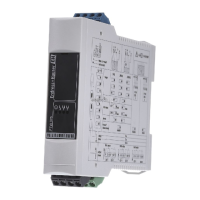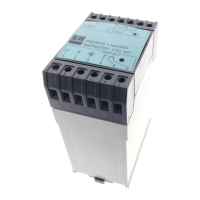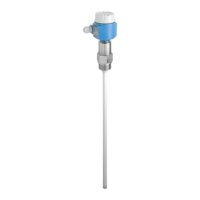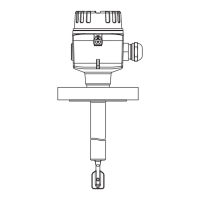7
Power supply
Electrical connection Terminal blocks
The removable terminal blocks are separated into intrinsically safe connections (at top of the
instrument) and non-instrinsically safe connections (at bottom of the instrument). Also, the
terminal blocks have different colours to make them more easily recognisable. Blue for the
intrinsically safe section and grey for the non-intrinsically safe section. This difference helps to
ensure safe wiring.
Connecting the measuring sensor
(at upper, blue terminal blocks)
The two-wire connecting line between the Nivotester FTL 325 P and the Liquiphant or Soliphant
measuring sensor can be either a commercially available installation cable or wires in a multi-wire
cable for measuring purposes. Line resistance may be a maximum of 25 Ω per wire.
If strong electromagnetic interference is expected, e.g. from machines or radio devices, a
screened cable must be used. Only connect the screen to the ground connection, and not to the
Nivotester.
Installing the measuring sensor in explosion hazardous areas
Please observe all local regulations on explosion protection concerning the type and installation
of intrinsically safe signal cabling.
Please refer to the Safety Instructions XA 133F for maximum permissible values of capacitance
and inductance.
Connecting signalling and control devices
(at lower, grey terminal blocks)
The relay function is dependent on the level and the fail-safe circuit.
If an instrument is connected at high inductance (e.g. contactor, solenoid valve etc.), a spark
suppressor must be installed to protect the relay contact.
Connecting the supply voltage
(at lower, grey terminal blocks)
For voltage variants, see the Ordering Information on page 13.
A fuse is built into the power supply circuit. This obviates the need to connect a fine-wire fuse in
series. The Nivotester is equipped with reverse polarity protection.
Supply voltage AC version:
• Voltage range: 85...253 V AC, 50/60 Hz
DC version:
• Voltage range: 20...30 V AC / 20...60 V DC
• DC supply: max. 75 mA (1-channel)
• DC supply: max. 165 mA (3-channel)
• Permissible residual ripple within tolerance: U
ss
= max. 2 V
Power consumption AC
1-channel: max. 1.7 W
3-channel: max. 4.2 W
DC
1-channel: max. 1.5 W (bei U
min
20 V)
3-channel: max. 3.3 W (bei U
min
20 V)

